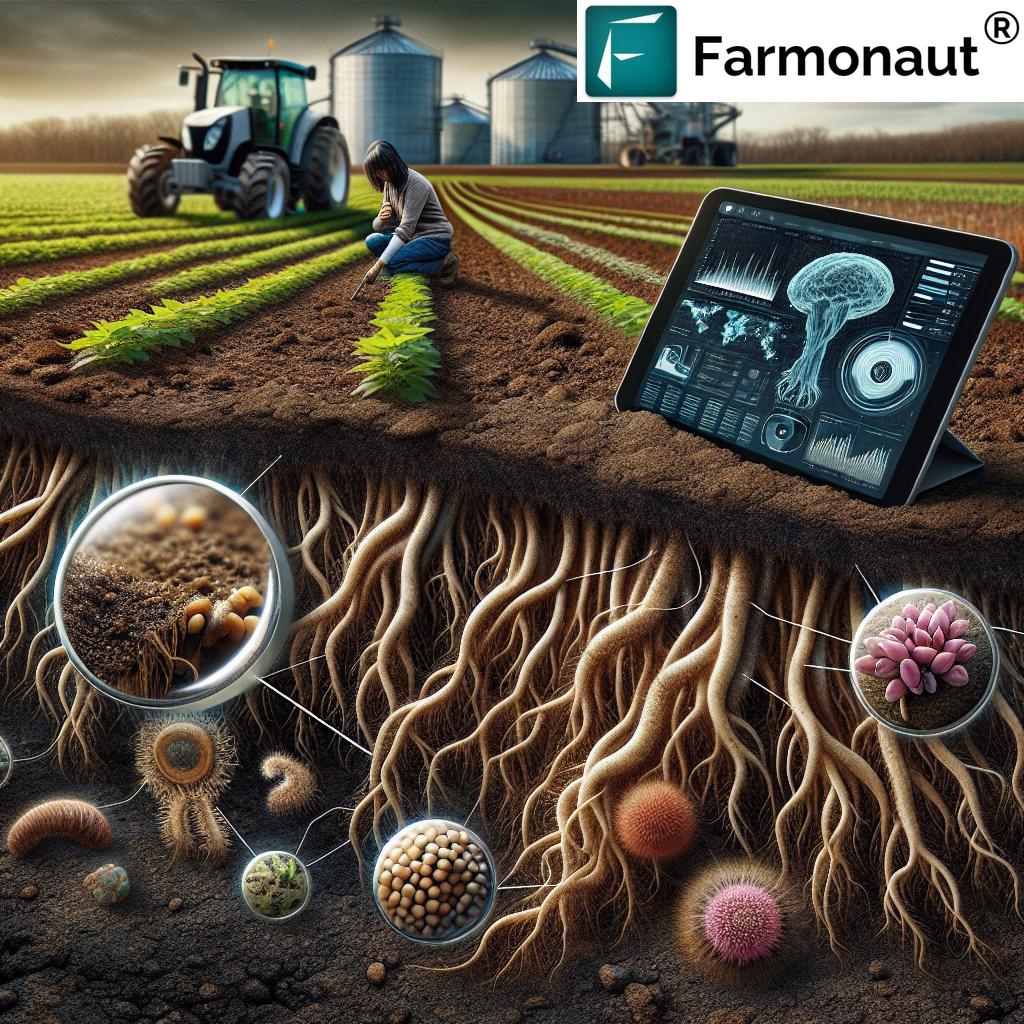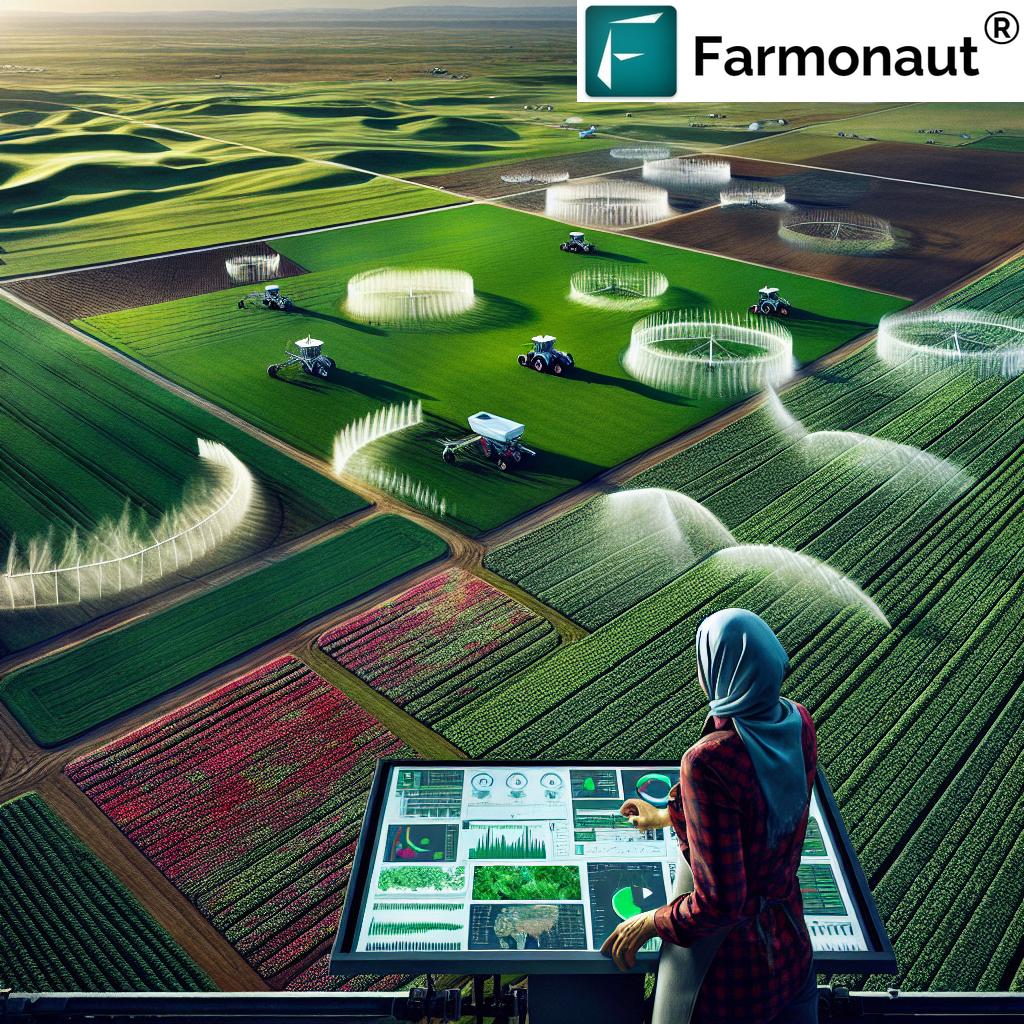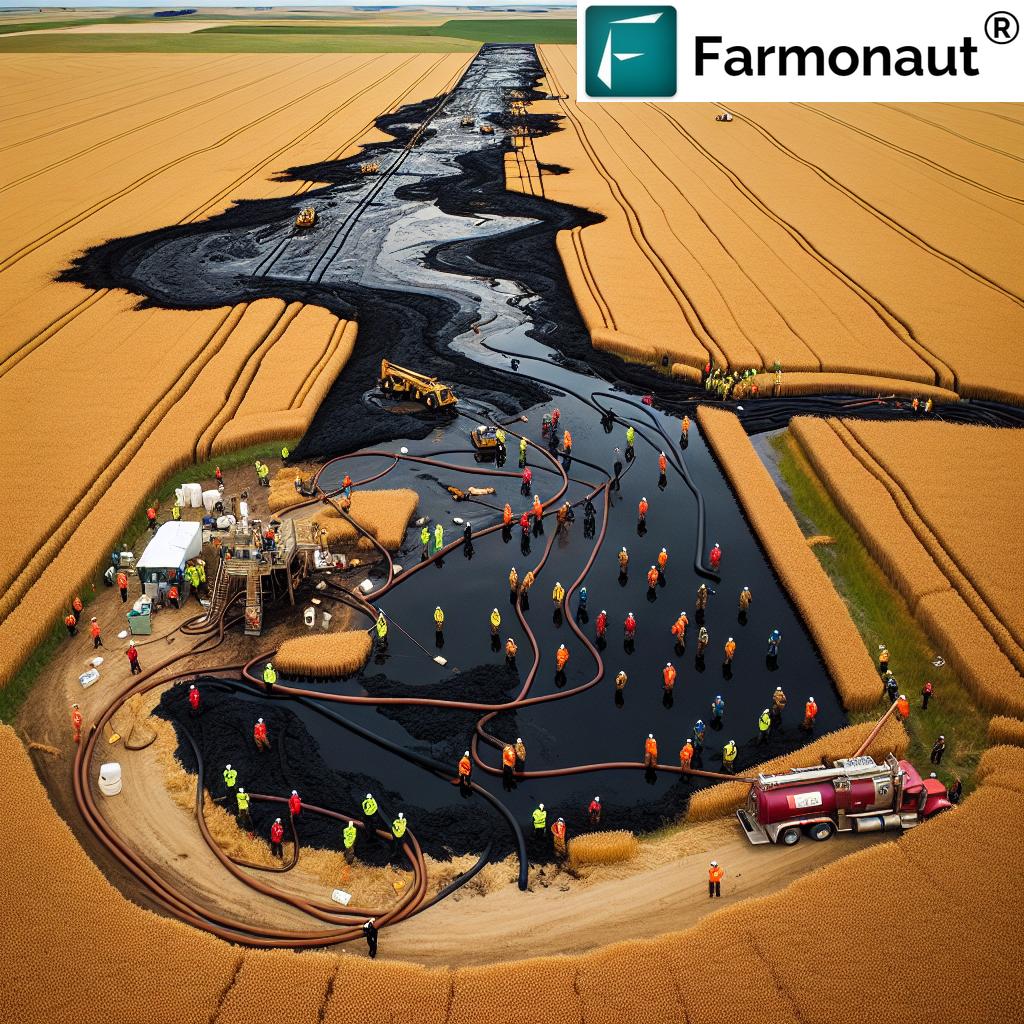Iowa Soybean Farmers: Boost Yields and Slash Nitrous Oxide Emissions with Smart Crop Rotation Strategies
“Smart crop rotation strategies can reduce greenhouse gas emissions by up to 33% in soybean and corn farming.”
In the heartland of America, Iowa’s soybean farmers are at the forefront of a sustainable agriculture revolution. As we delve into the latest research and innovative practices, we’ll explore how these farmers are not only boosting their yields but also playing a crucial role in mitigating climate change impacts. At Farmonaut, we’re excited to share these groundbreaking insights that are reshaping the future of environmentally conscious agriculture.

The Surprising Role of Soybeans in Nitrous Oxide Emissions
Recent research from Iowa State University has shed light on a crucial aspect of crop rotation that has long been overlooked. Contrary to popular belief, soybeans play a significant role in nitrous oxide emissions during the common corn-soybean crop rotation practiced by Iowa farmers. This revelation challenges the long-held assumption that legume crops have a negligible emissions footprint due to their lack of nitrogen fertilization.
The study, published in Nature Sustainability, reveals that approximately 40% of nitrous oxide emissions occur in the soybean year of the rotation. This finding has far-reaching implications for how we approach sustainable farming practices and emissions reduction strategies in agriculture.
Understanding the Science Behind Nitrous Oxide Emissions
To comprehend the significance of this discovery, we need to delve into the biological processes occurring in the soil. Professor Michael Castellano and his team, including postdoctoral researcher Tomas Della Chiesa, have uncovered that the production of nitrous oxide continues even in the absence of fertilizer application.
- Soil microorganisms play a key role in nitrogen cycling
- Residual nitrogen from previous crops contributes to emissions
- Legumes like soybeans can fix atmospheric nitrogen, influencing soil nitrogen dynamics
This complex interplay of factors means that farmers must look beyond simple fertilizer management to effectively mitigate nitrous oxide emissions from their fields.
Practical and Scalable Solutions for Emissions Reduction
The research team at Iowa State University didn’t stop at identifying the problem; they’ve also proposed practical and scalable solutions that can significantly reduce emissions while simultaneously boosting crop yields. Here are some of the key strategies they recommend:
- Planting winter cover crops: Implementing cover crops like oats or rye in the fall can protect bare soil during the off-season, reducing the duration for which soil is unprotected—a key contributor to nitrous oxide emissions.
- Using extended-growth soybean varieties: Opting for soybean varieties that can be planted earlier in the spring can lead to substantial benefits in both emissions reduction and yield increase.
- Optimizing planting schedules: Adjusting planting dates to take advantage of optimal growing conditions can enhance crop performance and reduce environmental impact.
By implementing these strategies, farmers could potentially achieve a 33% reduction in emissions and a 16% increase in yields. This win-win scenario demonstrates the power of innovative soil management techniques in modern agriculture.
The Role of Precision Agriculture Technologies
At Farmonaut, we understand the importance of leveraging cutting-edge technology to support sustainable farming practices. Our satellite-based farm management solutions provide farmers with real-time insights into crop health, soil moisture levels, and other critical metrics. By integrating these precision agriculture technologies into their operations, Iowa soybean farmers can make more informed decisions about resource management and environmental stewardship.
Our Jeevn AI advisory system takes this a step further by delivering personalized recommendations based on satellite data analysis, helping farmers optimize their crop rotation strategies and minimize nitrous oxide emissions.
The Impact of Climate Change on Agriculture
As we consider the future of farming in Iowa and beyond, it’s crucial to acknowledge the growing impact of climate change on agricultural practices. The research from Iowa State University underscores the urgency of addressing emissions in the agricultural sector, particularly as other industries make strides in decarbonization.
“Innovative soil management techniques can boost crop yields by 16% while reducing environmental impact in Iowa.”
Climate change presents both challenges and opportunities for soybean farmers:
- Shifting precipitation patterns may affect planting and harvesting schedules
- Rising temperatures could extend growing seasons but also increase pest pressures
- Extreme weather events may become more frequent, necessitating resilient farming practices
By adopting smart crop rotation strategies and leveraging precision agriculture technologies, farmers can enhance their resilience to these climate-related challenges while contributing to global emissions reduction efforts.
The Benefits of Cover Crops in Soybean-Corn Rotations
One of the most promising strategies highlighted in the Iowa State University study is the use of cover crops. These plants, grown during the off-season, offer multiple benefits to both the environment and crop productivity:
- Reduced soil erosion and improved soil structure
- Enhanced water retention and nutrient cycling
- Increased biodiversity and natural pest control
- Carbon sequestration and organic matter build-up
By incorporating cover crops into their rotation, soybean farmers can create a more sustainable and resilient cropping system that not only reduces nitrous oxide emissions but also improves overall soil health.

Optimizing Soybean Planting Strategies for Emissions Reduction
The research suggests that earlier planting of soybeans can lead to significant benefits in terms of both yield and emissions reduction. Here’s how farmers can optimize their planting strategies:
- Assess soil conditions: Use soil temperature and moisture sensors to determine the optimal planting time.
- Choose appropriate varieties: Select soybean varieties that are well-suited for early planting in your specific region.
- Monitor weather patterns: Utilize advanced weather forecasting tools to plan planting around favorable conditions.
- Implement precision planting: Use GPS-guided equipment to ensure accurate seed placement and optimal plant spacing.
By fine-tuning their planting approach, farmers can maximize the potential of their soybean crops while minimizing environmental impact.
The Role of Data Analysis in Sustainable Agriculture
At Farmonaut, we believe that data-driven decision-making is key to achieving sustainable and profitable farming practices. Our platform offers powerful data analysis tools that can help farmers:
- Track crop health and development throughout the growing season
- Identify areas of the field that may require additional attention or resources
- Analyze historical data to inform future crop rotation and management decisions
- Measure the impact of different practices on yield and environmental outcomes
By leveraging these insights, farmers can continuously refine their approach to crop rotation and emissions reduction, ensuring long-term sustainability and profitability.
Explore Farmonaut’s API for advanced data integration
The Economic Benefits of Sustainable Crop Production
While the environmental benefits of smart crop rotation strategies are clear, it’s equally important to consider the economic advantages for farmers. By implementing these practices, Iowa soybean farmers can:
- Increase crop yields and improve overall farm productivity
- Reduce input costs through more efficient resource use
- Potentially access premium markets for sustainably produced crops
- Enhance long-term soil fertility, reducing the need for synthetic inputs
These economic benefits demonstrate that sustainable agriculture practices can be both environmentally responsible and financially rewarding for farmers.
Comparison of Crop Rotation Strategies
| Rotation Strategy | Yield Increase (%) | N2O Emission Reduction (%) | Soil Health Impact |
|---|---|---|---|
| Soybean-Corn | 0 | 0 | Low |
| Soybean-Corn-Cover Crop | 16 | 33 | High |
| Extended-Growth Soybean-Corn | 12 | 25 | Medium |
| Soybean-Corn-Small Grain | 10 | 20 | Medium-High |
This table illustrates the potential benefits of different crop rotation strategies, highlighting the significant advantages of incorporating cover crops and extended-growth soybean varieties into the traditional soybean-corn rotation.
The Future of Sustainable Agriculture in Iowa
As we look to the future, it’s clear that sustainable agriculture practices will play an increasingly important role in Iowa’s farming landscape. The research from Iowa State University provides a roadmap for farmers to reduce their environmental footprint while maintaining or even improving productivity.
Key areas of focus for the future include:
- Continued research into optimizing crop rotations for emissions reduction
- Development of new soybean varieties tailored for early planting and extended growth
- Integration of advanced technologies like AI and machine learning in farm management
- Collaboration between farmers, researchers, and technology providers to drive innovation
By embracing these forward-thinking approaches, Iowa soybean farmers can lead the way in creating a more sustainable and resilient agricultural system.
How Farmonaut Supports Sustainable Farming Practices
At Farmonaut, we’re committed to providing farmers with the tools and insights they need to implement sustainable practices effectively. Our platform offers:
- Real-time crop health monitoring using satellite imagery
- AI-powered advisory systems for optimized farm management
- Weather forecasting and historical climate data analysis
- Resource management tools for efficient input utilization
By leveraging these technologies, farmers can make more informed decisions about their crop rotations, planting strategies, and overall farm management approach.
Conclusion: A Call to Action for Iowa Soybean Farmers
The research from Iowa State University presents a clear opportunity for Iowa soybean farmers to lead the charge in sustainable agriculture. By implementing smart crop rotation strategies, leveraging precision agriculture technologies, and embracing data-driven decision-making, farmers can significantly reduce nitrous oxide emissions while boosting their yields.
We encourage all Iowa soybean farmers to:
- Explore the potential of cover crops in their rotation
- Consider early planting strategies with extended-growth soybean varieties
- Utilize precision agriculture tools to optimize their farming practices
- Stay informed about the latest research and innovations in sustainable agriculture
Together, we can create a more sustainable and prosperous future for Iowa’s agricultural sector, setting an example for farmers worldwide.
FAQ: Smart Crop Rotation Strategies for Iowa Soybean Farmers
Q: What is the main benefit of implementing smart crop rotation strategies?
A: Smart crop rotation strategies can significantly reduce nitrous oxide emissions (by up to 33%) while simultaneously increasing crop yields (by up to 16%), promoting both environmental sustainability and economic profitability for farmers.
Q: How do cover crops contribute to emissions reduction?
A: Cover crops protect bare soil during the off-season, reducing the duration for which soil is unprotected. This helps minimize nitrous oxide emissions, improves soil health, and enhances overall farm sustainability.
Q: What role do soybeans play in nitrous oxide emissions?
A: Contrary to previous assumptions, soybeans contribute significantly to nitrous oxide emissions, accounting for about 40% of emissions in a typical corn-soybean rotation, even without direct nitrogen fertilization.
Q: How can farmers optimize their soybean planting strategies?
A: Farmers can optimize soybean planting by choosing extended-growth varieties, planting earlier in the spring when conditions allow, and using precision agriculture technologies to ensure optimal seed placement and spacing.
Q: What technologies can help farmers implement these strategies effectively?
A: Precision agriculture technologies, such as satellite-based crop monitoring, AI-powered advisory systems, and data analysis tools, can help farmers make informed decisions about crop rotation, planting times, and resource management.
















